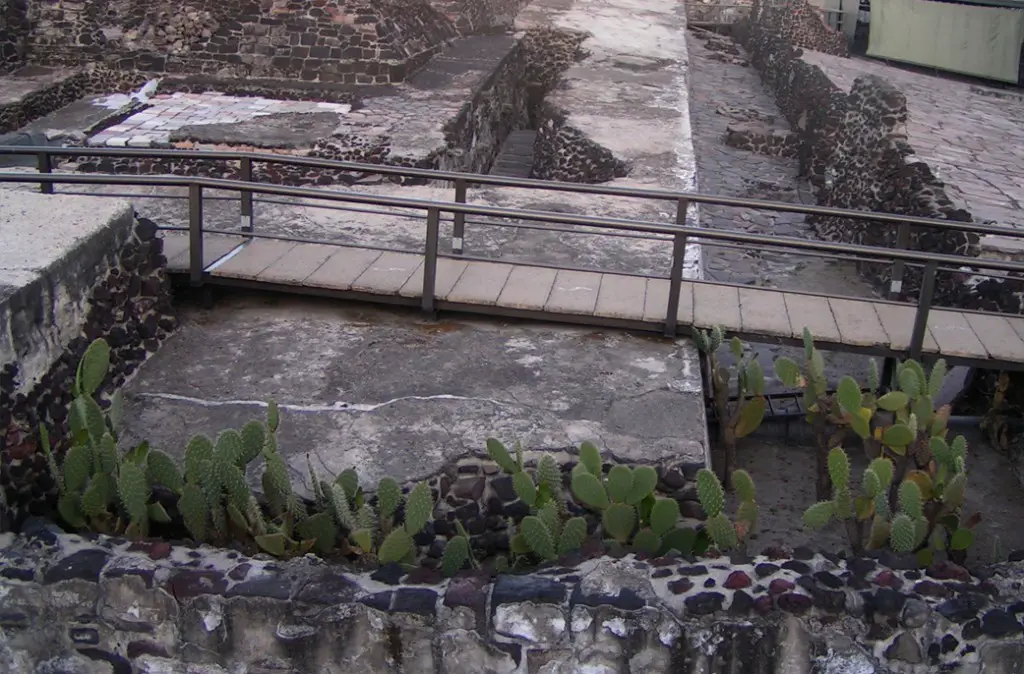Archaeologists work on human bones found at the Templo Mayor in the heart of Mexico City : INAH
A burial of more than 500 years of age, integrated by the complete skeleton of a man surrounded by more than 1,000 bones of children, young and adult people, was recently found by archaeologists from the National Institute of Anthropology and History (INAH-Conaculta) in the Historical Center of Mexico City, at the main temple of Tenochtitlan (Templo Mayor).
The discovery is unique since it is the first one where an adult skeleton was found surrounded by human bones of different aged persons, remarked archaeologist Raul Barrera Rodriguez, head of the INAH Urban Archaeology Program (PAU).
Besides osseous remains, a circular tezontle (red volcanic rock) structure was found; it contained a trunk, which, due to its placing, would correspond to one of the “sacred trees” associated to Huitzilopochtli’s shrine, and to the circular platform discovered in 2011 that corresponds to a ceremonial building in the sacred precinct of Tenochtitlan named cuauhxicalco.
Discoveries occurred during work conducted at Plaza Manuel Gamio to build the access vestibule of Templo Mayor archaeological zone and museum.
The burial was discovered nearly 5 meters below the street level, under a basalt-slab floor that corresponds to the fifth constructive stage of Templo Mayor (1481-1486) so specialists think bones match the same period.
“Bones were deposited directly over the soil surface: the complete skeleton was found at the western side of the funerary space – of 1.9 meters length by 65 centimeters width -, while the rest of bones were found around it, some of them grouped in small conjuncts, such as ribs and femurs”, described archaeologist Barrera.
Physical anthropologist Perla Ruiz, in charge of the excavation, recalled that the complete skeleton corresponds to a young woman; it was determined by the form of the skull and pelvis.
She pointed out that after concluding the extraction of remains, 1,789 bones were counted, including skulls of 3 children and 7 adults, as well as vertebrae and sternums that might have been cut. By the quantity of bone pieces, researchers believe they were exhumed in other place, but dating tests will clarify this.
–

The specialist commented that all the bones were sent to the Physical Anthropology Laboratory at Templo Mayor to undergo osteological analyses and determine aspects such as the number of individuals part of the offering, their sex and age, as well as pathologies and marks that reveal their activities while alive.
Rocio Morales, archaeologist in charge of researching the Prehispanic burial, pointed out that among found objects there is a small ceramic pot placed to the left of the skeleton, as well as tiny charcoal fragments.
“Thirty five meters away from the burial, a circular hollow tezontle structure was found; inside the stucco-covered, 1.6 meters diameter structure was found an Encino trunk that possibly dates from 1440-1469, according to the floor where it was located, which dates from the fourth constructive stage of Templo Mayor”, remarked Raul Barrera Rodriguez.
This structure was detected in front of the platform with serpent heads located in 2011, nearly 2 meters away and facing the place where Huitzilopochtli’s shrine was, suggesting that it is one of the “sacred trees” of Tenochtitlan ceremonial precinct.

The later is inferred from Bernardino de Sahagun and Diego Duran chronicles whom in their texts General history of the things of New Spain and The History of the Indies of New Spain, refer that there were different trees with ritual significance inside the sacred precinct, since “for Mesoamerican cultures, these trees’ branches supported the vault of heaven and conducted cosmic fluids; their roots were roadways to Mictlan or underworld”, explained Barrera Rodriguez.
“Mexicas believed that there were four trees that supported the nine levels of the vault of heaven and were conducts of cosmos. Benign and malign influences from the gods got to the world through their hollow trunks, being them responsible of causing severe damage or giving all the goods”.
“This finding confirms what historical sources describe, although at the moment we ignore the specific functions of this trunk – which is 2.2 meters long and 40 centimeters thick-, so archaeologist Edgar Nebot Garcia, from Templo Mayor Museum, continues the excavation and research of the circular structure that surrounded it, to determine its relation with the cuauhxicalco and what once was Huitzilopochtli’s shrine”, declared Barrera.
“The trunk –said archaeologist Barrera- was discovered under the floor level where 11 sculptures, broken in the Prehispanic period, were deposited, found in a ditch during 2010 and 2011. Under the sculpture fragments was found a tezontle rock, ceramic fragments and soil Prehispanic filling that covered a circular structure inside which a trunk fractured in two parts uprooted; it might have been intentionally fragmented, but we ignore the motives so far”.
Dara Valencia Hernandez, responsible of restoration works at Plaza Manuel Gamio, pointed out that the rests of the tree present a good conservation state, with some signs of insects’ attack, so it is being constantly fumigated, as a preventive conservation process.
“Once infrastructure works for the new vestibule are finished, the trunk and its circular structure will be exhibited where they were found, for visitors to know and enjoy” concluded Raul Barrera.






